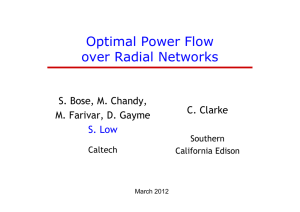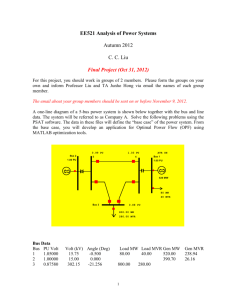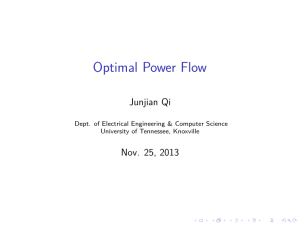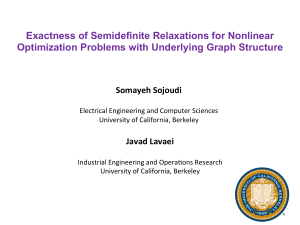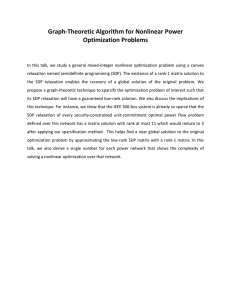Optimal Power Flow over Radial Networks Steven Low Caltech
advertisement
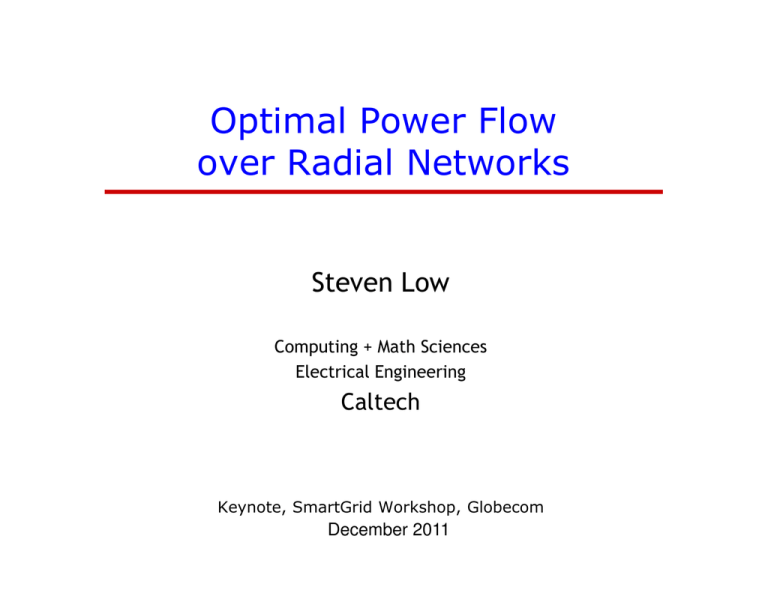
Optimal Power Flow over Radial Networks Steven Low Computing + Math Sciences Electrical Engineering Caltech Keynote, SmartGrid Workshop, Globecom December 2011 Outline Motivation Renewable generation in distribution networks OPF over radial networks Caltech: S. Bose, M. Chandy, M. Farivar, D. Gayme, J. Lavaei SCE: C. Clarke, M. Montoya, R. Neal, R. Sherick Worldwide energy demand: 16 TW Wind power over land (exc. Antartica) 70 – 170 TW electricity demand: 2.2 TW wind capacity (2009): 159 GW grid-tied PV capacity (2009): 21 GW Solar power over land 340 TW Source: Renewable Energy Global Status Report, 2010 Source: M. Jacobson, 2011 Challenge: uncertainty mgt High Levels of Wind and Solar PV Will Present an Operating Challenge! Source: Rosa Yang, EPRI Large-scale active network of DER DER: PVs, wind turbines, batteries, EVs, DR loads Large-scale active network of DER Millions of active endpoints introducing rapid large random fluctuations in supply and demand DER: PVs, wind turbines, batteries, EVs, DR loads Volt/VAR control Motivation: voltage support Static capacitor control cannot cope with rapid random fluctuations of PVs on distr circuits Inverter control Much faster & more frequent IEEE 1547 does not optimize VAR (unity PF) Two timescale control This talk: focuses on inverter control 8 Outline Motivation Renewable generation in distribution networks OPF over radial networks OPF: nonconvex optimization SDP relaxation SOCP relaxation Application: Volt/VAR control Optimal power flow (OPF) OPF is solved routinely to determine How much power to generate where Market operation & pricing Parameter setting, e.g. taps, VARs Non-convex and hard to solve Huge literature since 1962 In practice, operators often use heuristics to find a feasible operating point Or solve DC power flow (LP) Optimal power flow (OPF) Problem formulation Carpentier 1962 Computational techniques: Dommel & Tinney 1968 Surveys: Huneault et al 1991, Momoh et al 2001, Pandya et al 2008 SDP formulation: Bai et al 2008, 2009, Lavaei et al 2010 Bose et al 2011, Farivar et al 2011, Sojoudi et al 2011, Zhang 2011 Lesieutre et al 2011 Network model Nodes i and j are linked with an admittance Line: resistive and inductive I: Vector of injection currents Y:Admittance matrix Kirchhoff's Law: V: Vector of voltages Classical OPF min g f P ∑ k( k ) Generation cost k∈G over subject to g g P ,Q ( k k , Vk ) g k g k g k g k g P ≤P ≤ P g Generation power constraints Qk ≤ Q ≤ Qk V k ≤|Vk | ≤ V k KVL/KCL power balance Voltage magnitude constraints Classical OPF In terms of V: I k = (YV ) k = ekT YV Pk = Pkg − Pkd Sk :=Pk + iQk = Vk I k* Qk = Qkg − Qkd * = e V ( e YV ) = ekT VV *Y *ek T k T k = tr (Y *ek ekT ) VV * 1 424 3 Yk* * * * * * Yk +Yk * Yk −Yk = V Yk V = V V + iV V 2 2i 144244 3 144244 3 Pk Qk Classical OPF In terms of V: Pk = tr Φ kVV * Qk = tr Ψ kVV min k∈G * Yk* +Yk Φk : = 2 Yk* −Yk Ψk : = 2i d f P + P ∑ k( k k ) over s.t. V g k g k P − P ≤ tr Φ kVV ≤ P − Pkd g d k * d k g * d k Q k − Q ≤ tr Ψ kVV ≤ Q k − Q 2 k * V ≤ tr J kVV ≤ V 2 k Key observation [Bai et al 2008]: OPF = rank constrained SDP Classical OPF min ∑ tr M W k k∈G over W positive semidefinite matrix s.t. P k ≤ tr ΦkW ≤ P k Q k ≤ tr Ψ kW ≤ Q k 2 k 2 k V ≤ tr J kW ≤ V W ≥ 0, rank W =1 convex relaxation: SDP Semi-definite relaxation Non-convex QCQP Rank-constrained SDP Relax the rank constraint and solve the SDP Does the optimal solution satisfy the rank-constraint? yes We are done! no Solution may not be meaningful SDP relaxation of OPF min ∑ tr M W k k∈G over W positive semidefinite matrix s.t. P k ≤ tr ΦkW ≤ P k λ k , λk Q k ≤ tr Ψ kW ≤ Q k µ k , µk 2 k V ≤ tr J kW ≤ V 2 k Lagrange multipliers γ k,γk W ≥0 A ( λk , µ k , γ k ) := ∑ M + ∑( λ Φ k k∈G k k k + µk Ψ k + γ k Jk ) Sufficient condition Theorem opt A If has rank n-1 then opt W has rank 1 Duality gap is zero A globally optimal V opt is found All IEEE test systems (essentially) satisfy the condition! J. Lavaei and S. H. Low: Zero duality gap in optimal power flow problem. Allerton 2010, TPS 2011 OPF over radial networks Suppose tree (radial) network no lower bounds on power injections Theorem opt always has rank n-1 W opt always has rank 1 OPF always has zero duality gap Globally optimal V opt solvable efficiently A S. Bose, D. Gayme, S. H. Low and M. Chandy, OPF over tree networks. Allerton 2011 OPF over radial networks Suppose tree (radial) network no lower bounds on power injections Theorem opt always has rank n-1 W opt always has rank 1 OPF always has zero duality gap Globally optimal V opt solvable efficiently A Also: B. Zhang and D. Tse, Allerton 2011 S. Sojoudi and J. Lavaei, submitted 2011 Outline Motivation Renewable generation in distribution networks OPF over radial networks OPF: nonconvex optimization SDP relaxation SOCP relaxation Application: Volt/VAR control Model s gj s cj k j i power injection Sij i Vi S jk zij = ( rij , xij ) I ij j Vj radial (tree) network k Model s gj s cj k j i power injection Sij Kirchoff’s Law: Sij = S jk ∑S k:j~k 2 jk c j + zij I ij + s − s line loss g j load - gen Model s gj s cj power injection Sij Kirchoff’s Law: Sij = k j i S jk ∑S 2 jk c j + zij I ij + s − s g j k:j~k Ohm’s Law: Vj = Vi − zij I ij * i ij Sij = V I Model s gj s cj k j i S jk Sij ∑P Pij = jk 2 c j + rij I ij + p − p given load g j k:j~k Qij = c g Q + x I + q − q ∑ jk ij ij j j 2 k:j~k 2 2 Vi = Vj + 2 ( rij Pij + xijQij ) − ( r + x I ij 2 P 2 + Q2 ij ij = 2 Vi 2 ij 2 ij )I 2 ij Baran and Wu 1989 for radial networks Model s gj s cj k j i Each node described by just Sij, |Vi|2 S jk Sij ∑P Pij = jk 2 c j + rij I ij + p − p g j Given DG k:j~k Qij = c g Q + x I + q − q ∑ jk ij ij j j 2 VAR control k:j~k 2 2 Vi = Vj + 2 ( rij Pij + xijQij ) − ( r + x I ij 2 P 2 + Q2 ij ij = 2 Vi 2 ij 2 ij )I 2 ij g j −qi ≤ q ≤ qi Optimal VAR control min ∑ r l + ∑α v ij ij i~ j i i i g over (P,Q, v, q , l) lij := I ij vi := Vi 2 2 ∑ c g real power loss CVR (conservation s. t. Pij = Pjk + rij lij + p j − p j voltage reduction) k:j~k Qij = c g Q + x l + q − q ∑ jk ij ij j j k:j~k vi = v j + 2 ( rij Pij + xij Qij ) − ( r + x ) lij 2 ij Pij2 + Qij2 lij = vi − qi ≤ q gj ≤ qi 2 ij Optimal VAR control min ∑ r l + ∑α v ij ij i~ j i i i g over (P,Q, v, q , l) lij := I ij vi := Vi 2 s. t. Pij = ∑P jk c j + rij lij + p − p g j k:j~k 2 Qij = c g Q + x l + q − q ∑ jk ij ij j j k:j~k • Linear objective • Linear equality • Quadratic equality vi = v j + 2 ( rij Pij + xij Qij ) − ( r + x ) lij 2 ij Pij2 + Qij2 lij = vi − qi ≤ q gj ≤ qi vi ≤ vi ≤ vi 2 ij SOCP relaxation min ∑ r l + ∑α v ij ij i~ j i i i g over (P,Q, v, q , l) s. t. Pij = ∑P jk c j + rij lij + p − p g j k:j~k Qij = c g Q + x l + q − q ∑ jk ij ij j j k:j~k vi = v j + 2 ( rij Pij + xij Qij ) − ( r + x ) lij 2 ij Quadratic inequality Pij2 + Qijij22 ≥ lij = vii − qi ≤ q gj ≤ qi vi ≤ vi ≤ vi 2 ij Exact convex relaxation Theorem • SOCP relaxation is (convex and) exact • Original OPF problem has zero duality gap M. Farivar, C. Clarke, S. H. Low and M. Chandy, Inverter VAR control for distribution systems with renewables. SmartGridComm 2011 Outline Motivation – Uncertainty and large scale OPF over radial networks – OPF: nonconvex optimization – SDP relaxation – SOCP relaxation – Application: Volt/VAR control SCE Calabash circuit Ontario, CA Load and Solar Variation pic g i p Empirical distribution of (load, solar) for Calabash Improved reliability (p , p ) g i c i for which problem is feasible Implication: reduced likelihood of violating voltage limits or VAR flow constraints Energy savings Summary • More reliable operation • Energy savings M. Farivar, C. Clarke, S. H. Low and M. Chandy, Inverter VAR control for distribution systems with renewables. SmartGridComm 2011 Backup Slides Source: Steven Chu, GridWeek 2009 Features to capture Wholesale markets Day ahead, real-time balancing Renewable generation Non-dispatchable Demand response Real-time control (through pricing) day ahead balancing renewable utility utility users users Objective Day-ahead decision How much power ahead market? Pd should LSE buy from day- Real-time decision (at t-) How much x i should users consume, given realization of wind power Pr and Pd ? How to compute these decisions distributively? How does closed-loop system behave ? available info: decision: t – 24hrs t- ui (⋅), Fr (⋅) Pr , Pd* Pd* x i* Objective Real-time (at t-) Given Pd and realizations of Pr , choose optimal xi* = xi* ( Pd ; Pr ) to max social welfare Day-ahead * P Choose optimal d that maximizes expected optimal social welfare available info: decision: t – 24hrs t- ui (⋅), Fr (⋅) Pr , Pd* Pd* x i* Motivation: recap Optimal power flow [Bose, Gayme, L, Chandy] Motivation: core of grid/market operation, but slow & inefficient computation Result: zero duality gap for radial networks Impact: much faster and more efficient algorithm for global optimality to cope with renewable fluctuations Volt/VAR control [Farivar, L, Clarke, Chandy] Motivation: static capacitor-based control cannot cope with rapid random fluctuations of renewables Result: optimal real-time inverter-based feedback control Impact: more reliable and efficient distribution network at high renewable penetration Sample: optimal power flow Motivation Core of grid/market operation, but slow & inefficient (NP-hard) computation Result Prove conditions that enable convex relaxation Fast relaxation algorithm for optimality Surprising: all IEEE benchmark systems satisfy our conditions Impact Can enable real-time control to cope with renewable fluctuations Sample: Volt/VAR control Motivation Static capacitor control cannot cope with rapid random fluctuations of renewables Result Radial network admits convex relaxation Optimal phase shifter placement Optimal real-time inverter based VAR control Impact More reliable and efficient distribution network

